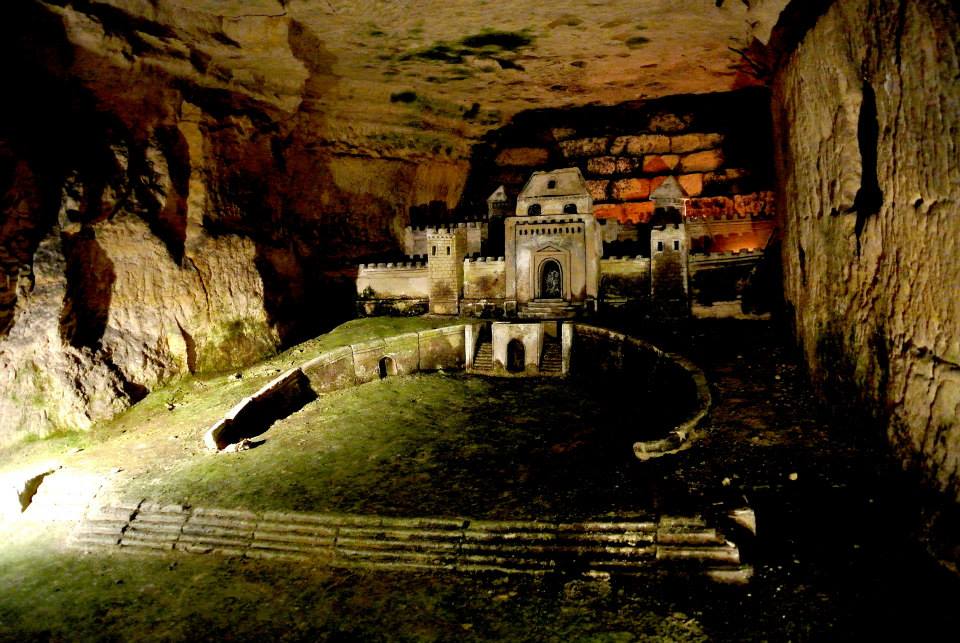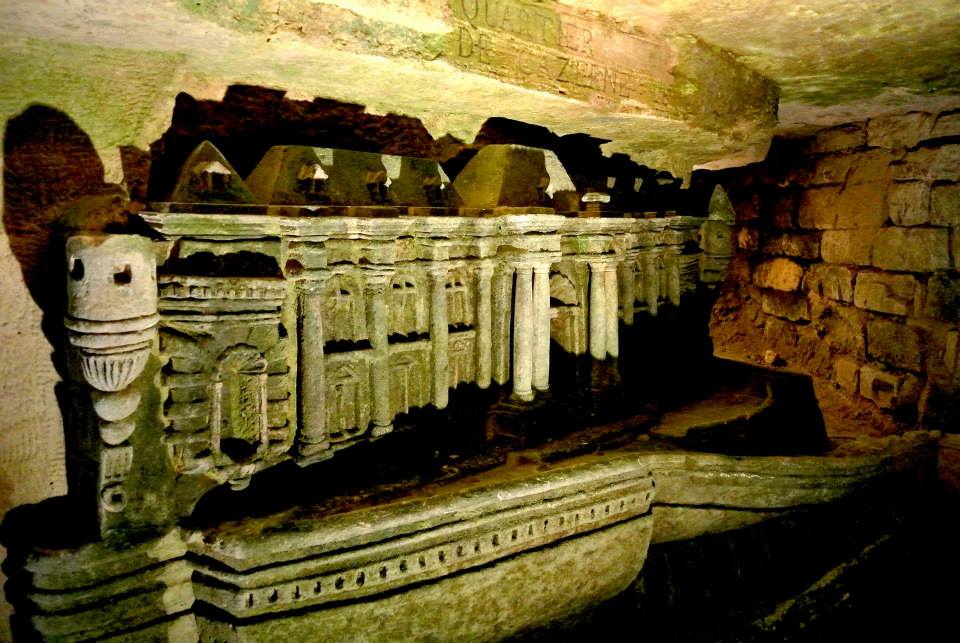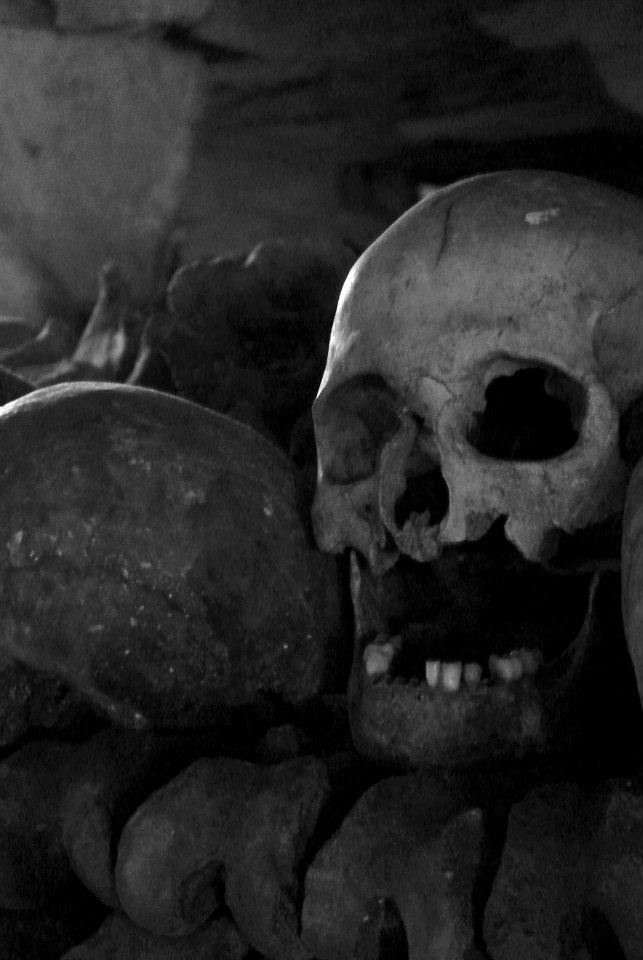No bones about it: If you think piles of skulls and hallways formed of bones are pretty effin’ cool (like us), then the Catacombs of Paris are for you.
The bones of about 7 million Parisians were relocated and stacked artistically in the Catacombs below the city
Wally’s parents don’t share our morbid curiosity about death. So there were a couple things we had to hit before they arrived: one being Père Lachaise Cemetery, and the other being the Catacombs.
The Catacombs are an underground ossuary (literally “bone receptacle”), said to contain the remains of 7 million or so Parisians.
“It took over 15 months to relocate the bones of an estimated 7 million Parisians from local cemeteries. ”
Get there early.
Our friends Kent and Michael had advised us to get there right at opening. There’s usually a long wait, as they only permit a limited number of visitors in at a time.
We were both hungry that morning, but because we had woken up later than we intended to (damn jet lag), we decided not to stop for breakfast — we were not going to miss the Catacombs.
Grab breakfast nearby.
We took the 88 bus to les Catacombes. The line that had formed was already around the block and longer than the previous day. I held our place in line while Wally sought out coffee and something for us to eat.
Across the street, he found a Paul, a chain of pâtisseries and boulangeries that serves a surprisingly good breakfast. That day he got us two cafés crèmes and jambon and brie sandwiches on crusty baguettes.
People-watch and admire the nearby statue to kill time in line.
A tot in a bright orange corduroy coat ahead of us was finding it difficult to wait in line and wandered away from her parents, the hurried footsteps of her father not far behind. She paused to entertain a couple of water bottle vendors by imitating the nearby Lion of Belfort statue, which our friend Kent has dubbed Aslan, from the Chronicles of Narnia. The little girl raised both her tiny hands and roared, which made us and the vendors laugh.
The entrance to the Catacombs is marked with an inscription that translates to “Stop! Here lies the Empire of Death”
Don't Stop! Here Lies the Empire of Death
We entered the dark green building located at Place Denfert-Rochereau, paid our admission and descended the spiral staircase 60 feet beneath the streets of Paris.
One of the first things we encountered on our exploration was a rock-cut palace chiseled from memory between 1777-1782 by a quarry inspector who had served time in a prison situated across from it. According to the sign next to the sculpture he died from a “cave-in while trying to build an access stairway at this location.”
I couldn’t help but wonder if he had been added to the crypt we were about to explore.
Isn't it strange how similar "la morte" (death) and "l'amour" (love) are in French?
Poor Souls
Most of the disinterred bones are from the Cimetière des Innocents in Paris. It was the chosen local burial ground, as the site had been consecrated with a handful of dirt from the Holy Land.
This sign shows that most of the remains in the Catacombs came from the Cemetery of the Innocents and were moved in the 1700s
So numerous was the quantity of burials there, that most were interred in large open pits that were covered over when full. Once these were overflowing, the exhumed bones were stored within arcades around the perimeter of the cemetery.
In an effort to reduce the risk of fatal disease caused by bacteria spread from the putrefying remains, Alexandre Lenoir, the Lieutenant-General of Police, proposed that the remains be stored and placed in the abandoned subterranean limestone quarries beneath Paris. Stone from these mines was used in the construction of both the Louvre and Notre Dame Cathedral.
Even though the Catacombs were not affiliated with a particular church, they were still considered a consecrated site. The bones had been transferred from respective cemeteries led by clergy, who performed benediction rites upon them.
It took over 15 months to relocate the bones of an estimated 7 million Parisians from Les Innocents and other local cemeteries. The remains were dropped down chutes by night to workers, who stowed them away in the passageways.
Skulls, femur and tibia bones were packed high and tight, some up to 10 feet deep. The Catacombs are just a small part of the quarries, which date back to Roman times. The bones reinforce these mines, which had been known to collapse, taking the buildings above down with them.
One part of the Paris Catacombs is covered in graffiti scratches. (Did you hear something behind us?)
Famous Residents
Among these are the remains of Charles Perrault, the author of the Tales of Mother Goose, architect Solomon de Brosse (who designed the city's Luxembourg Palace) as well as a few poor souls who lost their heads to the guillotine.
Napoleon, wishing to outdo the ancient Catacombs of Rome, allowed Louis-Étienne Héricart de Thury, Inspector-General of Quarries, to elaborately rearrange the site, resulting in an impressive if macabre monument.
Duke’s only pretending to be scared. He loved exploring the Catacombs
Plaques were placed throughout the passages noting from which cemetery the remains were taken. Some inscriptions came from classical sources, others from sacred texts. A biblical passage in Latin — “Memento Creatoris tui in diebus juventutis tuae antequàm veniat tempus afflictionís” — translates to "Remember your Creator in the days of your youth, before the evil days come."
During World War II, the tunnels were used by Parisian members of the French Resistance.
The chamber containing the Rotonde des Tibias in particular was thought to have impressive acoustics, and in 1871 it hosted a 45-member orchestra playing Chopin's funeral march.
Because the guards stagger groups who can enter at a time, we found we mostly had the tunnels to ourselves, which allowed Wally to get up to his usual antics
It had rained recently, and some sections of the tunnels were dripping, rendering the floor beneath them wet. We heard that the Catacombs close when there’s been a bad storm because they get flooded.
At the end of the adventure — Wally kept saying it was like real-life Dungeons & Dragons, sans the dragons — there's a table where they go through your bags. Apparently, there's a large number of people who try to steal a skull or bone.
No one was stationed at the table when we left, so of course Wally was bummed we could have gotten away with pilfering a skull or two.
Arriving back at the Métro, I had to hop the turnstile, as my ticket didn't validate. My novice technique was not graceful — the space is limited once you hop said turnstile and proceed to squeeze through the half-door behind it. But having seen numerous kids do so, I felt I was now a true Parisien. –Duke
“At the end, there’s a table where they go through your bags. Apparently, there’s a large number of people who try to steal a skull or bone.”
If you’re interested in this subject, check out the gorgeous book The Empire of Death: A Cultural History of Ossuaries and Charnel Houses by Paul Koudounaris.

























